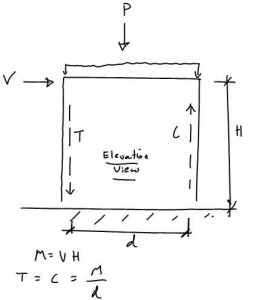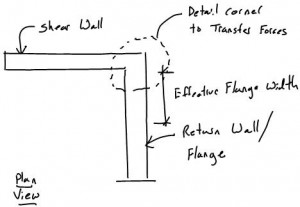Partially Grouted Reinforced Masonry Shear Wall Design
We will cover a simplified design method for designing masonry shear walls. I don’t have a direct reference at this time however the Reinforced Masonry Engineering Handbook 6th edition and MSJC TMS402 -05/08/11 could be referenced. The TMS 402-08 is referenced for allowable stress values. This method is generally conservative when used for low rise structures with generally small lateral loads and relatively longer shear walls. When designing shear walls for taller buildings or shear walls with high aspect ratios (height/length) and/or large overturning moments a different method of analysis/design is recommended.
References
Ref 1. MSJC 2005 and 2008 Building Code Requirements and Specification for Masonry Structures and Related Commentaries (AKA TMS 402 or ACI 530). Found here
Ref 2. Masonry Structures Design and Behavior, Second Edition by Drysdale, Hamid and Baker(the Third edition found here)
Ref 3. Reinforced Masonry Engineering Handbook 6th Edition by Max Porter. Found here
Steps for the simplified design method:
- Determine forces on wall: Axial (Pr), Moment (Mr) and Shear (Vr)
- Determine overturning tensile reinforcement needed:
- Use a force couple to represent the moment: Tension = Compression = Mr/d where d is the moment arm of the force couple.
- Consider dead load to resist uplift – I have seen anywhere from 6*t (6 x wall thickness) to half the wall length used. The 6*t comes from the allowable effective wall width when considering out of plane loads (Ref 1 Section. If there is a return wall (masonry wall perpendicular to shear wall) at the end of the wall, the wall may be used as a flange. The effective width of the flange for tension should limited to 0.75*wall height or the length of the flange.
- Overturning compression:
- There is some engineering judgment required. Usually the compression force is considered to act uniformly over a certain area. Similar to concrete design (ACI 318) and the rectangular stress block. I have seen different effective areas used however commonly 6*t or 0.8*half the wall length is used.
- Pure axial – For axial design see here (post coming soon)
- Find the reduction factor for axial load and check Pr vs Pa (allowed axial load) (MSJC Ref 1 Section 2.3.3)
- Reinforcement is not considered effective in compression unless ties are provided.
- Shear reinforcement: For shear design see here
- Determine if shear reinforcement is required. If shear reinforcement is required the reinforcement is design for the full shear force.
- Note that even though the shear reinforcement is designed for the shear force this only increase the allowable shear stress and is still limited i.e. shear reinforcement only provides an increased allowable stress and cannot keep adding reinforcement for further shear strength. Similar to concrete ACI318 design.
- Determine vertical shear reinforcement required = 1/3 of the horizontal shear reinforcement.
- Deflection
- We will save this for another post. Usually this is not a major concern for short buildings with relatively small loads and long shear walls.


1 comment for “Reinforced Masonry – Shear Walls ASD Simplified Method”